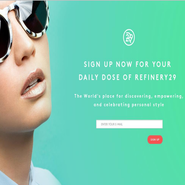 Refinery29 email subscription ad
Refinery29 email subscription ad
A new study conducted by social media advertising technology company Adaptly, Facebook and fashion and lifestyle Web site Refinery29 demonstrates the value of sequencing advertisements to consumers.
The report for "Research Study on Sequenced for Call to Action vs. Sustained Call to Action" highlights the research technique used on Facebook with Refinery29 to determine the effectiveness of sequencing ads compared with sustained ads. The study concludes that sequencing ads that call consumers to action are more valuable than standard calls-to-action, a tactic that can be leveraged by all marketers.
"The findings of this study can be beneficial to any marketer interested in measuring and optimizing on a conversion path," said Melissa Goidel, chief revenue officer at Refinery29, New York.
"Even brand advertisers seeking to change brand perceptions and shape brand affinities can leverage digital to drive email subscriptions, mobile application downloads, coupon downloads and even online sales," she said.
"This report showcases a winning strategy for sequencing advertising messages for maximum impact and creating a path for CRM even before the purchase."
The “The Science of Social Media Advertising: A Research Study on Sequenced for Call to Action vs. Sustained Call to Action” report used Refinery29’s most engaged email subscribers to create a Custom Audience on Facebook of 2 million people. The audience was randomly assigned to three test groups. One group received three sequenced for call-to-action ads, another group received three call-to-action focused ads and the last was not targeted. Results were determined after 12 days.
Sequencing ads
The Custom Audience for the study was created by gathering the most active 5 percent of Refinery29’s email subscribers on Facebook. Using a lookalike tool on Facebook, Adaptly was able to expand this Custom Audience to about 2 million people.
The first test group of the Custom Audience received three sequenced for call-to-action images over a series of 12 days. These images did not immediately call for the Facebook user to subscribe for the Refinery29 email list.
The first image generally marketed the company. The second image provided more specific information about what one might receive from Refinery29 emails. The third image directly asked for the Facebook users to subscribe for the email list.
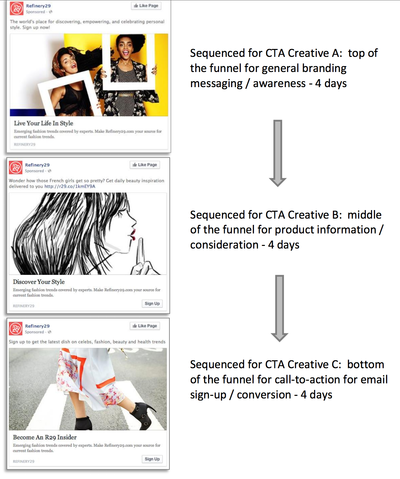 Sequenced ads
This marketing strategy brings people down the brand’s funnel. The first part of the funnel is an ad for brand message. The next step is the middle of the funnel ad for consideration that leads to the bottom of the funnel ad for call to action.
Sequenced ads
This marketing strategy brings people down the brand’s funnel. The first part of the funnel is an ad for brand message. The next step is the middle of the funnel ad for consideration that leads to the bottom of the funnel ad for call to action.
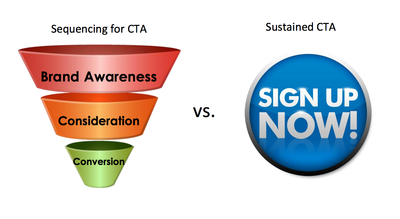 Call-to-action techniques
The second test group of the report, the sustained call-to-action group, was targeted for 12 days with three call-to-action ads. Each ad specifically asked viewers to subscribe with the brand.
Call-to-action techniques
The second test group of the report, the sustained call-to-action group, was targeted for 12 days with three call-to-action ads. Each ad specifically asked viewers to subscribe with the brand.
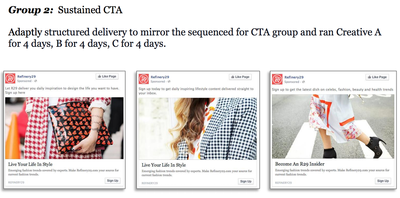 Sustained ads
Finally, the third group served as the control and did not receive any Facebook advertisements from Refinery29 during the 12 day period.
The results of the study found that those individuals who were targeted by the sequenced for call-to-action ads were more likely to subscribe to the email subscription list.
Sustained ads
Finally, the third group served as the control and did not receive any Facebook advertisements from Refinery29 during the 12 day period.
The results of the study found that those individuals who were targeted by the sequenced for call-to-action ads were more likely to subscribe to the email subscription list.
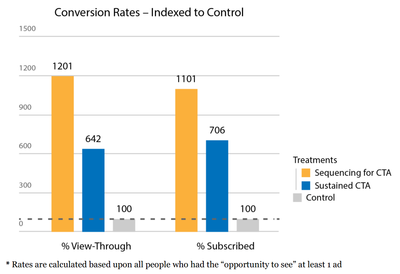 Graph showing results for email subscriptions sign-ups
Research found that in the sequenced for call-to-action ads, the second image, or the consideration ad, was the highest viewed and drove the most subscriptions. This image provided specific information and asked Facebook users a question soliciting engagement with the viewer.
The research surrounding this reports offers brands marketing techniques for Facebook, but can be used across social media platforms. The report specifies digital marketing practices that help brands build consumer engagement.
Funnel technique
Refinery29 used the funnel method to encourage Facebook users to engage with its email subscription list, but brands have been using a similar sequencing idea for campaigns through teasing a product or a video.
For instance, French leather goods maker Longchamp teased its fall 2013 campaign through social media to keep consumers engaged and drive interest in new products.
The brand created a Facebook event along with daily posts and a teaser video to make sure the “Bigger than Life” campaign stayed at the top of fan’s social media feeds. Since consumers may be overwhelmed with the number of new campaigns, brands need to make sure campaigns have staying power to ensure fan engagement (see story).
Similarly, Italian fashion maison Valentino continued to tease its newest men’s fragrance Uomo with a sneak peek of its campaign video that may sustain interest in the scent until it is available worldwide in 2015.
The atelier was keeping the campaign effort vague for the fragrance debut to increase anticipation and leave consumers wanting more. By segmenting and protracting the campaign consumers likely followed along and return to the brand’s Facebook and Web site for updates (see story).
Teasing a campaign or a product is similar to the funnel technique, but brands must take into consideration how the video is teased. Similar to the email subscription ads for Refinery29, brands need to consider the sequencing pattern that Adpatly, Facebook and Refinery29 have found to be successful.
Forming ads into a sequence that eventually asks for a call-to-action from consumers can allow a brand to slowly release a concept to consumers without being overtly demanding.
"[The goal was] fundamentally, to answer a basic yet elusive question: whether delivering marketing messages by leading a consumer down the marketing funnel is more effective than simply delivering a sustained call to action message," said Sean O'Neal, president at Adaptly, New York.
"It may seem obvious, but many advertisers would find it counterintuitive to elongate an advertising campaign by more gradually moving an audience down the brand funnel, versus just attempting to convert them on a direct-response message," he said.
"Or, assuming different mediums are purposeful for different strata of the marketing funnel, and not looking holostically at what digital can deliver."
Final Take
Graph showing results for email subscriptions sign-ups
Research found that in the sequenced for call-to-action ads, the second image, or the consideration ad, was the highest viewed and drove the most subscriptions. This image provided specific information and asked Facebook users a question soliciting engagement with the viewer.
The research surrounding this reports offers brands marketing techniques for Facebook, but can be used across social media platforms. The report specifies digital marketing practices that help brands build consumer engagement.
Funnel technique
Refinery29 used the funnel method to encourage Facebook users to engage with its email subscription list, but brands have been using a similar sequencing idea for campaigns through teasing a product or a video.
For instance, French leather goods maker Longchamp teased its fall 2013 campaign through social media to keep consumers engaged and drive interest in new products.
The brand created a Facebook event along with daily posts and a teaser video to make sure the “Bigger than Life” campaign stayed at the top of fan’s social media feeds. Since consumers may be overwhelmed with the number of new campaigns, brands need to make sure campaigns have staying power to ensure fan engagement (see story).
Similarly, Italian fashion maison Valentino continued to tease its newest men’s fragrance Uomo with a sneak peek of its campaign video that may sustain interest in the scent until it is available worldwide in 2015.
The atelier was keeping the campaign effort vague for the fragrance debut to increase anticipation and leave consumers wanting more. By segmenting and protracting the campaign consumers likely followed along and return to the brand’s Facebook and Web site for updates (see story).
Teasing a campaign or a product is similar to the funnel technique, but brands must take into consideration how the video is teased. Similar to the email subscription ads for Refinery29, brands need to consider the sequencing pattern that Adpatly, Facebook and Refinery29 have found to be successful.
Forming ads into a sequence that eventually asks for a call-to-action from consumers can allow a brand to slowly release a concept to consumers without being overtly demanding.
"[The goal was] fundamentally, to answer a basic yet elusive question: whether delivering marketing messages by leading a consumer down the marketing funnel is more effective than simply delivering a sustained call to action message," said Sean O'Neal, president at Adaptly, New York.
"It may seem obvious, but many advertisers would find it counterintuitive to elongate an advertising campaign by more gradually moving an audience down the brand funnel, versus just attempting to convert them on a direct-response message," he said.
"Or, assuming different mediums are purposeful for different strata of the marketing funnel, and not looking holostically at what digital can deliver."
Final Take
Nancy Buckley, editorial assistant on Luxury Daily, New York
